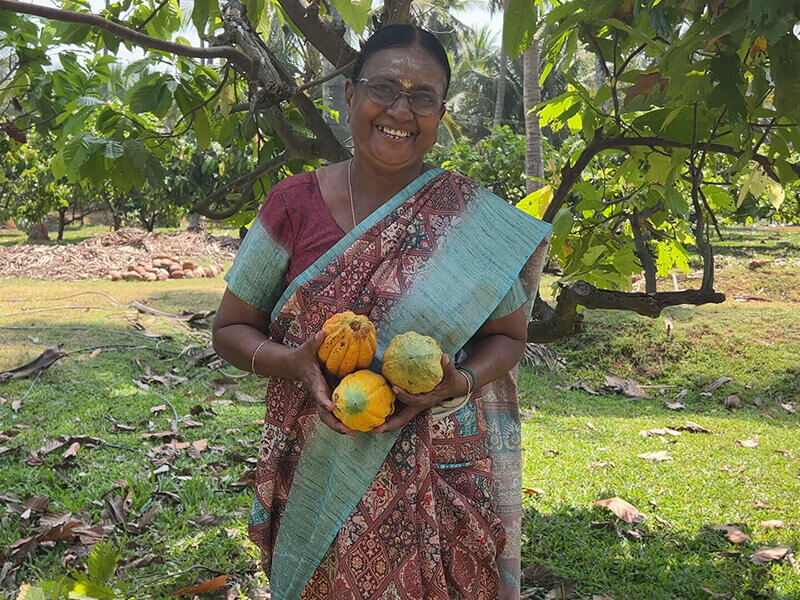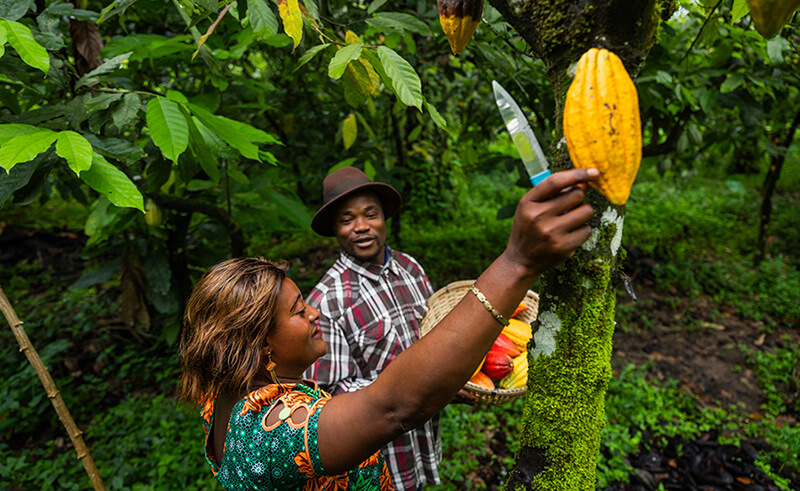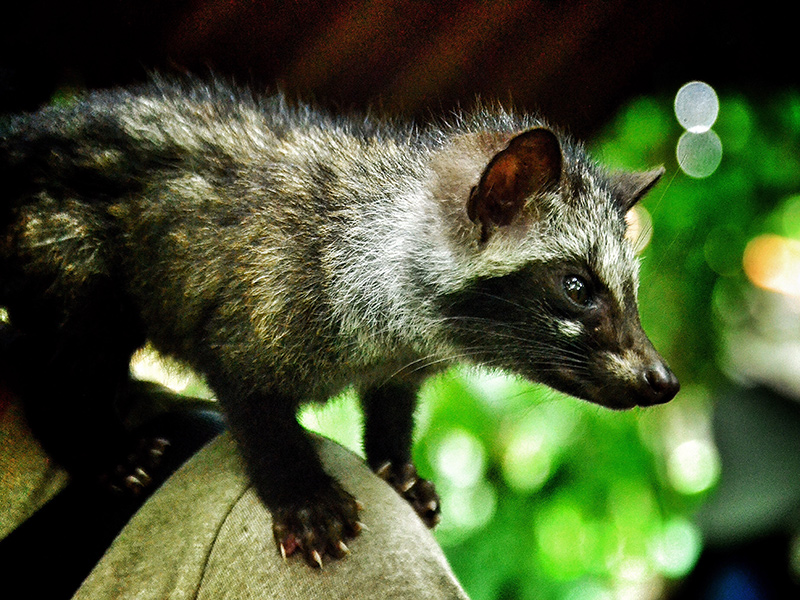The 500-odd farmers of Gurha Kumawatan, a village in arid Rajasthan, are now millionaires thanks to polyhouse farming. Their hard work, innovation and unlimited ambition offers a path to prosperity for others in India.
Indian chocolate farmers are making an unexpected profit as cocoa production in West Africa plummets.
 TR Vivek
TR Vivek 
The small, dark godown abutting M Dharmambigai’s large home with a larger courtyard in Kottur, a village 15 km to the south of Pollachi town in Tamil Nadu, has never housed stock so precious.
The value of gunny bags of cocoa beans stacked unevenly, without a great deal of care, is currently more than Rs 12 lakh and almost guaranteed to go up to Rs 15 lakh soon.
The lottery of climate change is such that the misery of farmers in one country is an opportunity to make windfall gains for others in a different continent.
The price of cocoa beans, the primary raw material for chocolate, has more than tripled in the last year. In March 2024 alone, it rose from $7100 a ton to $10455. In fact, chocolate prices now trade higher than industrial metals such as copper.
Brown gold
The rise is fuelled by crippling shortages in Ghana and Ivory Coast that produce nearly 55% of the world’s cocoa beans. According to the International Cocoa Organization (ICCO), a grouping of 51 countries comprising the biggest exporters and consumers of the bean, the West African production decline that set off since 2016 is a combination of cocoa trees infected with the deadly swollen shoot virus disease, illegal mining, which has reduced the number of cocoa farms, ageing trees and prolonged dry and wet spells of weather.

There are far deeper socio-economic reasons why West African cocoa production will not recover anytime soon resulting in chocolate becoming ever more expensive. Despite the global craze for chocolates, the farmers in Ivory Coast and Ghana that produce cocoa have remained some of the most exploited and poorly paid in the world.
Terminal decline
According to a JP Morgan report, cocoa is still largely cultivated by smallholder farmers, many of whom struggle to make a living income and lack the means to reinvest in their land — which translates to lower yields over time. “Cocoa is a market where the grower produces a very high-value good but receives a very low share of the actual value chain. As a result, replanting rates are very low and cocoa trees are ageing,” said Tracey Allen, an agricultural commodities strategist at JP Morgan in the report.
In other words, the poor West African farmers have no incentive to take good care of their plantations, or even grow cocoa at all. Many are happy to switch to crops like rubber or sell their land to metal miners.

India’s opportunity
Dharmambigai is a 71-year-old, widowed farmer with no children, who manages her 25-acre holding pretty much by herself. Clad in a pale-green-pink-and-maroon printed silk-cotton sari, wearing large steel-frame glasses, a forehead full of vibhuti and sandalwood paste on the nose bridge, she has no clue about global cocoa production trends. “I’m just happy that my cocoa bean stock of 1.25-1.5 tons is fetching a price of Rs 800 a kg. Some of my relatives have told me not to sell now because prices may go up to Rs 1000 soon,” beams Dharmambigai, speaking in the endearing, singsong western Tamil Nadu accent and manner that includes addressing younger people as ‘kannu’ [darling]. She is one of the few remaining cocoa farmers in Tamil Nadu’s Pollachi region.
India is a lightweight in the global cocoa production landscape. It barely produces 27,000-30,000 tons, far below the domestic demand of more than 70,000 tons. Can Indian farmers like Dharmambigai begin to prosper when those in West Africa give up? It’s not so simple.

A hard nut
The popularity and easy availability of chocolate as a consumer product does not help appreciate the exacting nature of cocoa farming. Cocoa is a delicate, sensitive plant that requires high rainfall, heat, yet constant shade and a great deal of moist air. As a result, their home is restricted to the region 20 degrees north and south of the equator.
In India, cocoa is a shortish tree growing up to six metres with a broad shady canopy and leaves three-to-four times bigger than that of mango. Unlike its natural home in tropical forests of West Africa and South America, Indian cocoa is grown in the shade of vast coconut and arecanut or betelnut plantations as an intercrop.
The coastal areas in Andhra Pradesh’s Godavari delta produce most of India’s cocoa followed by west-central Karnataka’s hill regions and places like Pollachi on the foothills of the Western Ghats in Kerala and Tamil Nadu. The cocoa fruit, when ripe and ready for harvest, resembles the papaya. But the cocoa fruit is much woodier, requiring a wooden mallet and considerable force to be cracked open.
Cocoa is an evergreen tree that yields fruits twice a year: June and July is when the big harvest comes after the minor season that lasts from November to January. Yields on a commercial scale are possible only after five years and trees remain productive for up to 30 years.

“My husband planted cocoa seedlings 13 years ago in our coconut farms. He passed away shortly thereafter. Since then, I’ve been taking care of it in his memory, even if there wasn’t not much income from it. Most farmers in our region have cut their cocoa trees because the price never went above Rs 200/kg,” says Dharmambigai, as she conducts the daily survey of her farm on creaking arthritic knees, riding on her husband’s beloved Willys Jeep of the 1960s vintage.
Her own cocoa farm would yield more if she bothered to prune the trees regularly and pay greater attention to them. Another disadvantage of growing cocoa as an intercrop to coconut and arecanut is that cocoa pods become the primary source of food for squirrels and wildlife such as the Asian palm civet. Civets find it easier to drill through the relatively soft fruits of cocoa compared to the rock-hard coconuts.
Harvesting and processing cocoa nuts is labour intensive. In a region that allows both men and women in the workforce industrial employment at Coimbatore’s factories and Tiruppur’s textile mills, farmhands are always at a premium.
A typical cocoa fruit or pod contains 30 to 40 beans and there are about 30 pods per tree. When the fruit is broken the seeds are covered in a thin layer of mucous-like pulp that tastes like a sugar-free version of sitaphal or custard apple.
Dharmambigai removes the beans from the pods, and stores them in large bamboo baskets covered by banana leaves or tarpaulin. After five to seven days of fermentation in a cool, dark space, the cocoa beans are sun dried for several days. That’s when they get the deep brown colour and the coveted chocolate flavour. You need about 500-600 dried beans to make a kg of cocoa powder.
Indian cocoa is far more astringent than west Africa’s and therefore needs more intensive processing. African beans have subtler and complex flavours to justify the premium.
“India cocoa farmers have benefited in the short term and they can take advantage of high global prices. As an intercrop to coconut and areca, our cocoa is more environmentally sustainable. We don’t grow it on forest land that has been cleared for plantation. We have our own climate change problems. Unseasonal cyclones destroy cocoa flowers in East Godavari district. Poor south west monsoon impacts output in Western Ghats,” says Krishna Kumar HM, the managing director of Central Arecanut and Cocoa Marketing and Processing Co-operative Limited (Campco), India’s largest cocoa procuring cooperative that sells chocolates under its own brand and to multinational firms such as Nestle.
The 500-odd farmers of Gurha Kumawatan, a village in arid Rajasthan, are now millionaires thanks to polyhouse farming. Their hard work, innovation and unlimited ambition offers a path to prosperity for others in India.